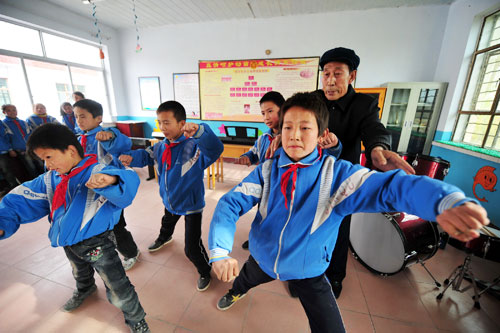|
 |
|
LOCAL OPERA: A Qinqiang Opera artist gives a lesson to a group of boys at a primary school in Gaotai County of west China's Gansu Province (ZHANG MENG) |
Now, the quality of art education mainly depends on parents rather than schooling. Urban parents enroll their children in outside institutions to learn musical instruments, dancing, painting, and so on. This is nearly impossible for rural children due to their families' poor economic situation.
The examination-oriented education has added to the difficulties. When exam approaches, art classes are always cancelled and replaced by major subjects to help students get a better score in the exams.
The absence of art education in rural areas widened the urban-rural gap. Rural children who miss out on creative arts are in a more disadvantageous position in future competitions in college and society.
"Since so many rural primary schools couldn't give art lessons, the educational equality is severely damaged," said Zhang Zhiyong, Vice Director General of Shandong Provincial Department of Education. "This will ultimately hurt the fundamental interests of rural children and undermine their overall competence."
Fortunately, the importance of art education has been more and more recognized in recent years.
"Art education cultivates a child's mind, inspires their creativity, and leads them to pursue their life goals," said Zhou Yuanqing, China's former vice minister of education. Without the ability to appreciate art, he added, a person is incomplete.
"It should be the goal of art education to train comprehensive, high-quality talents," Zhou continued. "And the role of art education is irreplaceable by other subjects."
Chinese education experts agree that with the rapid development of economy and education, the art education of primary school students has entered a new phase. It is essential for the government to increase input, strengthen management and form a scientific teaching assessment system that includes artistic skills.
Against this backdrop, many successful examples have emerged in rural schools. Nanbu County of Nanchong, Sichuan Province, is one of the 58 pilot places of a rural school art education program announced by Ministry of Education in 2000. A decade ago, the county suffered from a severe lack of art teachers.
To solve this problem, the county took various measures to increase the number of art teachers, including graduates from art colleges as full-time art teachers and part-time art teachers.
The school recruited accomplished teachers of urban schools to take turns teaching art in rural schools, training new teachers, and testing their abilities through various competitions. In the years that followed, the school's art education has made great achievements.
As part of the effort to promote art education, teachers of east China's Jiangsu Province recorded excellent music lessons and sent the videos to rural schools. The exchange has strengthened ties between urban and rural schools. The province also sends music teachers to give lessons to students in remote areas.
Similar practices have also been adopted in Beijing and Tianjin municipalities, and provinces such as Hebei, Guangdong and Zhejiang.
"These practices were conducive to narrowing the art education gap between urban and rural areas," said Peng Jixiang, Deputy Secretary General of the Art Education Committee in the Ministry of Education.
In addition to improving teaching resources of rural schools, many places have enriched the contents of art education by introducing folk arts into the classroom.
Local folk arts such as straw plaiting and Tanhuang Opera deepened the students' recognition and love for their cultural roots. They boost rural children's interest in art and enhanced their understanding of various art forms. In Sichuan Province, local folk arts like paper-cutting, decorative lanterns, root carving and clay sculpture have been introduced into primary schools. Many have become the children's favorite lessons.
Email us at: yuyan@bjreview.com | 